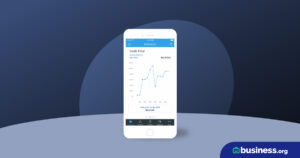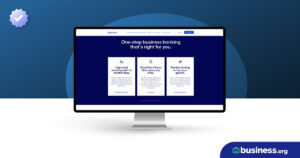💸 See if your business qualifies for a tax credit worth up to $26k per employee. 📞 Call Now: 855-979-9597
How To Sell at a Farmers Market & Grow Your Business
We are committed to sharing unbiased reviews. Some of the links on our site are from our partners who compensate us. Read our editorial guidelines and advertising disclosure.
Farmers market season is finally here! Hello, honey sticks, fresh produce, wooden key chains, and sourdough bread. The whole block’s set to smell amazing every Saturday morning for the remainder of the summer—or longer if you’re lucky.
Not only is attending a farmers market dreamy in a Hallmark sort of way, but it can also be a perfect venue for getting to know other vendors and people in your community, spreading the word about your business, and bringing in some extra money. Farmers markets are a growing outlet for small businesses, too, with nearly 9,000 markets nationwide and about $1 billion in total sales, according to the USDA’s Agricultural Marketing Research Center.
Selling at a farmers market is not as easy as setting up a booth and getting your product in front of passersby, though. There are a few things you need to sort out first—like permits, applications, your POS device, and a strategy to retain customers.
By signing up I agree to the Terms of Use and Privacy Policy.
Preparing to sell at a farmers market
Selling your products at the local market seems like a no-brainer, but bringing your entire inventory each time isn’t feasible. You need to strategize and figure out what shoppers are looking for and will pick up on the spot.
Farmers markets are more than produce, honey, bread, jams, and jellies, so don't give up if traditional offerings aren’t your jam (pun intended). Your market may have guidelines for vendors available online, or you can always visit to see if your products would be a good fit.
At my local markets, vendors sell many nontraditional products like wooden action figures, jewelry, art, and vintage clothes. I don’t always buy the first time I walk through the market, but seeing what’s available gets me excited about coming back the next week and picking through booths for birthday gifts or fun tchotchkes to liven up my house.
What does it cost to sell at a farmers market?
Farmers markets can be lucrative but only if you keep the extra fees that come with selling at a local market in mind. Most farmers markets charge a fee to set up a stall. Booth fees are generally charged per day and can range anywhere from $20 to $50 or more. What you pay can depend on the size of your booth and where it is in the market. Rental terms vary by the market, but you can rent a booth by the week, season, or even up to six months.
Of course, there are other costs to consider beyond vendor fees. These include permits and licenses, insurance, banking, and more.
Permits and licenses
Before you even think about setting up your booth, make sure you have the right permits to be a vendor. These might include a business license, food handling permit, mobile retail license, food sales establishment license, occupational permit, solicitation license, or vendor’s permit. Each state—and sometimes county or city—differs, so double-check that you know what is legally required for you to sell goods.
Still trying to figure out where to start? Ask the market organizers or other vendors
Insurance
Depending on the market, you may be required to have liability insurance to be a vendor. If you have employees working your booth, check into workers’ comp insurance too.
Supplies and marketing
You may need to invest in specific equipment and supplies to sell at a market. This includes tables, tents, tablecloths, signs, and displays. All this is on top of the costs of creating or sourcing products and packaging them.
Add in marketing costs, especially if you’ve only had an ecommerce business before. You might want to look at printing cards to hand out or signage to point people in the right direction.
Banking
A business bank account is a must before you start selling at a market, online, or anywhere else. Keeping your business and personal finances separate from the beginning can save you headaches later.
Business banks—like Bluevine, Found, and Novo—help you organize your finances and plan ahead by offering streamlined financing options. There are different business bank accounts, but you can get started with a basic checking account, which should be free.
Supply chain
Let’s look into the future. Your booth is a big hit. You sell out each week and talk to more and more customers, but:
- Can you keep up with the demand?
- Do you have enough inventory?
- Can you afford to stock up?
- Is your supply chain steady?
- Is your product seasonal?
Building a following takes time and effort—all that can go to waste if supply chain issues impact your business. To avoid that happening, you may want to focus on a few big sellers instead of spreading your time and money across more products. You could also focus on growing your inventory in the down months between markets or wait until you have a stockpile to start selling.
Point-of-sale system
You need to plan how to handle transactions. Do you accept cash or cards or both? Are you bartering? Sales are smoother if you’ve figured out those logistics.
Since many people don’t carry cash, you need a way to handle credit cards and digital payments like Apple Pay. Having the right point-of-sale system allows you to seamlessly accept card payments and move through transactions quickly. Some of our favorites are Square, Shopify, Clover, and QuickBooks.

Sage HR offers an intuitive interface that visualizes employee schedules.
- Easily receive employee requests
- View schedules across numerous timeframes
- One-click time-off approval and easy schedule templates
Selling at a farmers market
Market culture is about walking around and socializing. If your booth is not eye-catching, marketgoers might pass by without pausing. Make sure you stand out. Think clean, bright colors and easy-to-read signs that make it clear exactly what you’re selling and how much it costs.
Offering samples is another great way to get people to stop and learn about your product—and it gives you an opportunity to say thank you for supporting your small business.
Whether people buy or not, keep their interest. A local market isn’t just about selling out. It is about making your business known in the community. Your booth might be the first point of contact with potential customers. Make sure people know where and how to find your business. You can mention that you’ll be at the market every week and hand out business cards with a list of your social media handles and website or a QR code that points to your online shop.
After the market is over
The market is closed. You’ve sold a few items, connected with other vendors, and acquired a ton of new followers on your socials. Now you need to put that exposure to work for you and get customers to the finish line, even if it is only online.
Start by keeping your social media active and pointing customers to your online store. If you don’t have a website, get one ASAP. There are many great website builders—such as Wix, Squarespace, WordPress, or GoDaddy—that make it easy to connect ecommerce shops and sell your products.
This is what your website should do:
- Speak to your brand and maintain consistency, tying in with your market booth. You build brand recognition by using the same logo, colors, fonts, etc.
- Be easy to use. You want customers to find the products they remember from the market and more.
- Be shareable. Customers help you market your products by sharing ones they like and sending screenshots to friends.
And the most important thing to do after your first market? Go back! See how things go for a couple of weeks, build familiarity with shoppers, and see if selling at a farmers market is right for your small business.
Related reading
Disclaimer
At Business.org, our research is meant to offer general product and service recommendations. We don't guarantee that our suggestions will work best for each individual or business, so consider your unique needs when choosing products and services.





